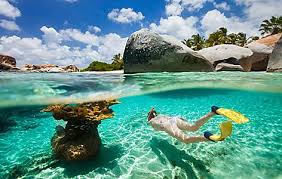Commonwealth of Dominica
 The Commonwealth of Dominica is located on one of the Lesser Antilles. The island of the same name, which this small country occupies, is of volcanic origin. Like the entire archipelago of the Lesser Antilles, it appeared as a result of the collision of the Caribbean Plate with other tectonic formations in the area (with the North American and South American plates). From the east, Dominica is washed by the waters of the Atlantic, and from the west – the Caribbean.
The Commonwealth of Dominica is located on one of the Lesser Antilles. The island of the same name, which this small country occupies, is of volcanic origin. Like the entire archipelago of the Lesser Antilles, it appeared as a result of the collision of the Caribbean Plate with other tectonic formations in the area (with the North American and South American plates). From the east, Dominica is washed by the waters of the Atlantic, and from the west – the Caribbean.
The island has all the conditions for the development of agriculture: it is abundantly covered by rivers and streams, and the mountainous nature of the area gives them swiftness and power (up to 53% of the electricity comes from hydroelectric power stations). Numerous waterfalls form on the elevation. Rainfall is so plentiful that the island supplies surplus fresh water to its neighbors: it is halfway between Puerto Rico and Trinidad and Tobago, and from the north and south it neighbors, respectively, Guadeloupe and Martinique. The island’s water “map” is supplemented by geysers, sulfur and mineral springs and “boiling” lakes – echoes of the volcanic past of Dominica. Now volcanic ash serves as a decoration of beaches, coloring them in black and gray. Ash is also an excellent fertilizer for a number of export crops, as well as flowers and various tropical vegetation, due to which Dominica is sometimes called the “Island of the Caribbean Nature”.
Around the 4th millennium BC. e. the island was inhabited by the Arawak Indians, whom, after the fourteenth century. replaced by more warlike Caribbean Indians. On Dominica, which they called Wai-Tukubuli, they arranged a real stronghold.
The militancy of the Caribbean in the XV century. frightened off the Columbus expedition, one of the ships of which, having remained for reconnaissance and even having found a convenient bay (now it is called Prince Rupert), was afraid to land on the shore. So the Europeans, already knowing about Dominica, “forgot” about it for almost a hundred years, during which the Indians managed to protect the welfare of their island from foreigners, preventing the Spaniards, French or English from staying here. The British behaved most brutally, mercilessly destroying the local population. The reason for applying for Dominica was the fact that the English crown in the person of Jacob I Stuart (1566-1625), and then his son Charles I (1600-1649) in 1627 granted a patent to the island to his favorite – the Scottish aristocrat James Hay, Earl of Carlisle (1590-1636). A skilled craftsman to carry out the king’s most delicate instructions in other countries, Carlisle earned the trust of eminent persons, and they in turn indulged his innocent passion for love to lead the colonies, and at a distance, through governors and governors. In parallel, the French bought the lands of the islands from the Caribbean – this is how the political competition of France and England, stretching for several centuries, for dominance on Dominica began. By 1727, a small colony of about fifty French families appeared on the island. Settlers cultivated plantations and cultivated sugarcane and coffee, which they also brought to the island. But still the island went to Britain: in 1756 the British captured it, and in 1763 secured the right to own the conclusion of the Paris peace between Great Britain and Portugal on the one hand and France and Spain on the other. Under the terms of this treaty, the four islands from the Lesser Antilles archipelago, which were considered neutral, were divided between France and England. Dominica went to England. Dominica on a geographical map.
The British built two forts: Roseau and Portsmouth. Moreover, Roseau became the capital, and Portsmouth still serves as one of the largest ports in the country. The British analyzed the geological reserves of the island and divided it into parts, some of which they sold, others allowed French settlers to live in exchange for an oath of allegiance, and a small area was left as a reservation for the Caribbean. But even later, the island still passed into the possession of the French, and then again the British. In agriculture in the XVIII century. radical changes occurred: a drop in sugar prices forced planters to retrain for growing citrus fruits (in particular, lime), which is still an important article in the economy. The plantations were traditionally cultivated by the forces of slaves: slavery in Dominica was canceled in 1838, and before that, slave uprisings broke out repeatedly and even a major clash with the authorities in 1844 called “Negro War”.
Despite all efforts to establish the economy of the island, this colony has always remained one of the poorest among the possessions of Britain. At the beginning of the XX century. Dominica, more and more independent in administrative terms, has repeatedly appealed to Britain for support to overcome repeated economic crises: agriculture of this country, among other factors, is extremely tied to climatic features – typhoons (and earlier volcanic eruptions) more than once put its economy on the brink survival. From 1958 to 1962, Dominica existed as the West Indies Federation. The country gained full independence in 1978.




